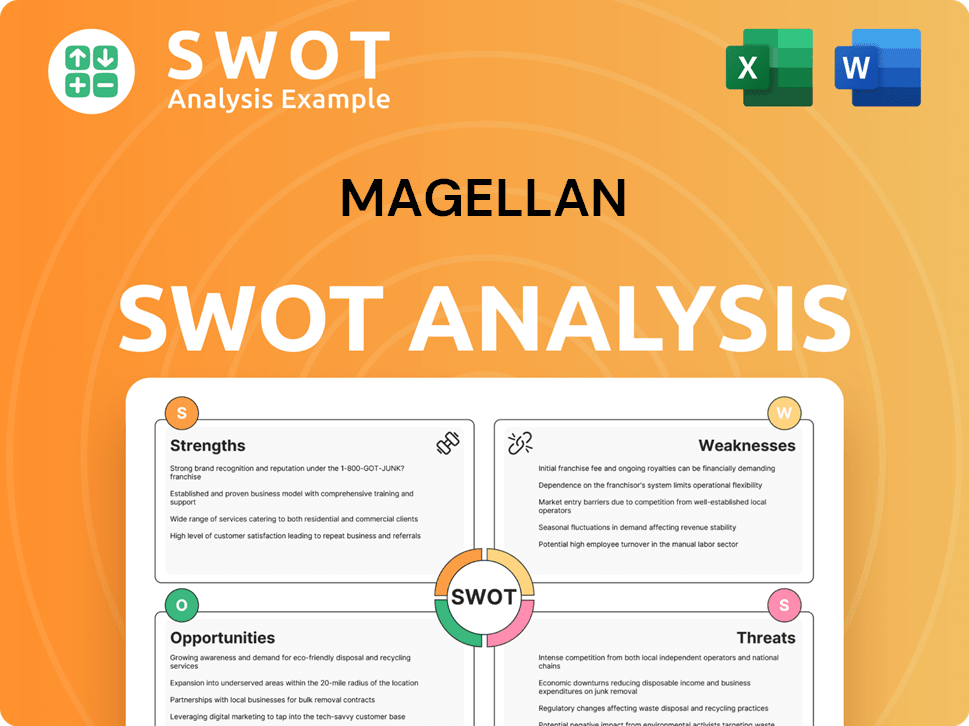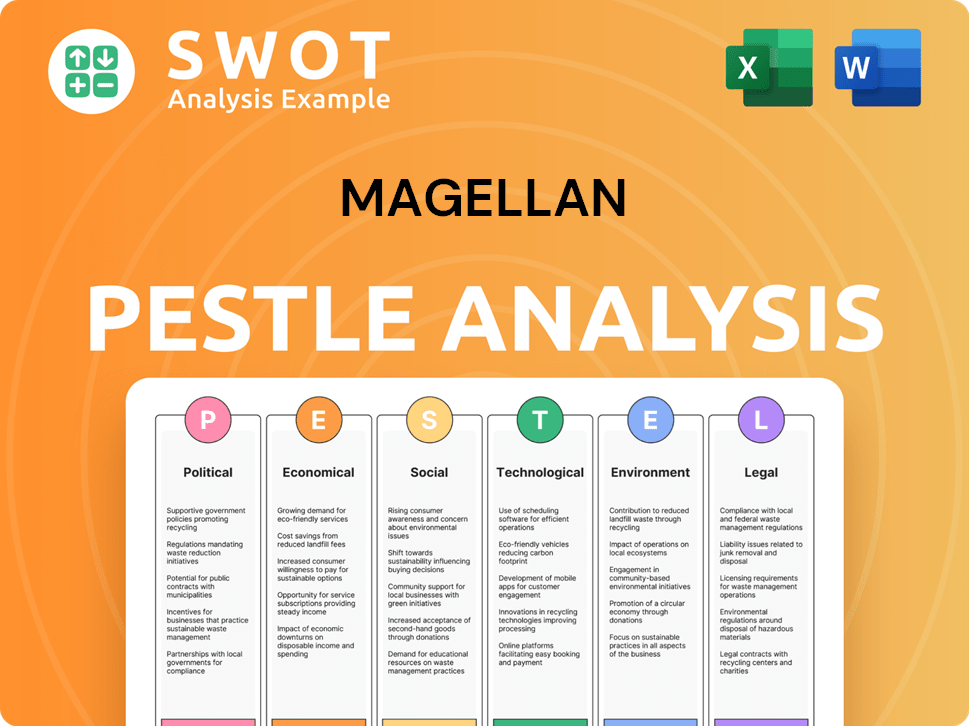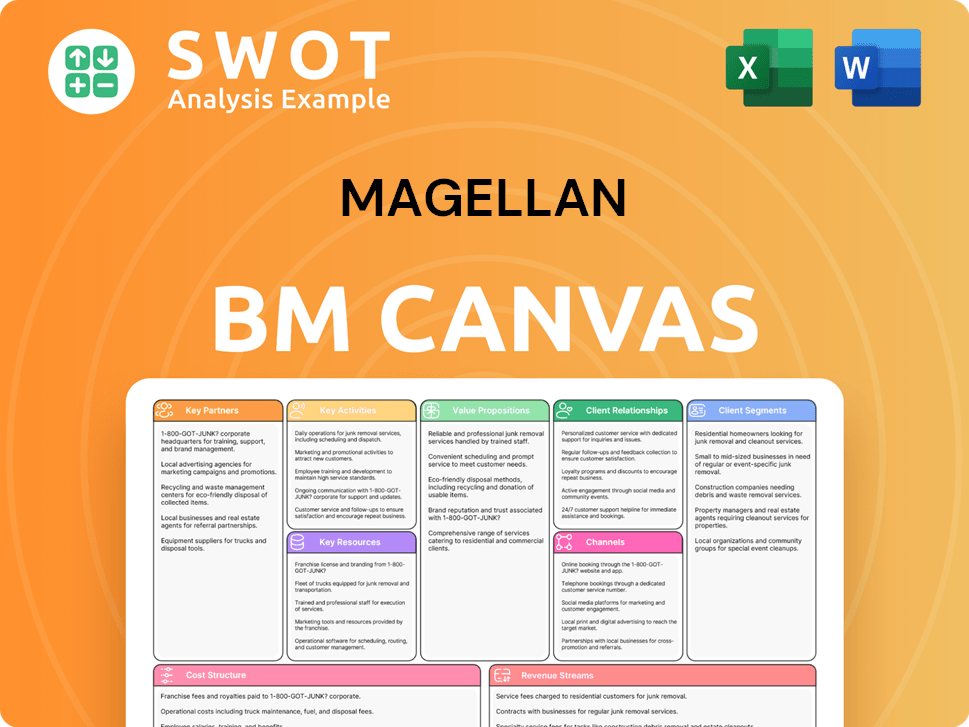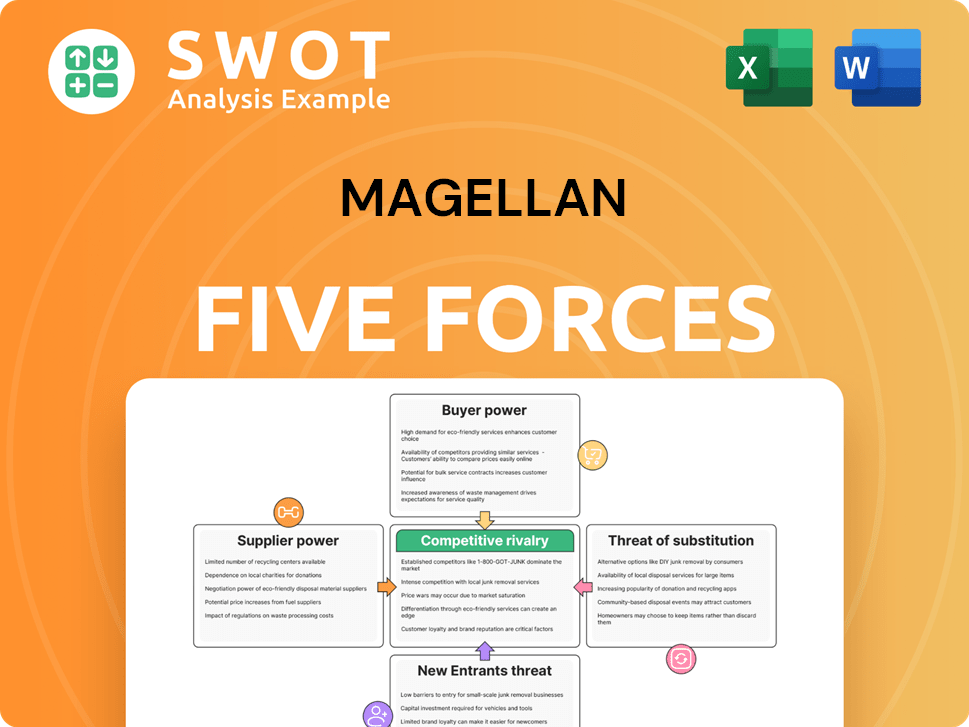Magellan Bundle
How Did Magellan Company Take Flight in Aerospace?
From its humble beginnings in 1952 as Orenda Engines, Magellan Aerospace has charted a remarkable course through the global aerospace industry. Initially focused on advanced propulsion systems, the company quickly became a key player in the post-war aviation boom. Today, Magellan stands as a leading global supplier, manufacturing critical components for both commercial and military markets.

Magellan's early innovation included the development of the Orenda Iroquois engine for the Avro Arrow, showcasing its commitment to cutting-edge technology. This early success highlights the Magellan SWOT Analysis. The company's evolution reflects strategic expansions and technological advancements, solidifying its position as a global aerospace leader. This detailed exploration into the Magellan Company history will reveal how it has adapted and thrived, leaving a lasting impact on the industry.
What is the Magellan Founding Story?
The story of the company, now known as Magellan Aerospace, begins with the establishment of Orenda Engines in 1952 in Malton, Ontario, Canada. This initiative by A.V. Roe Canada Limited was a direct response to the increasing demand for advanced jet propulsion systems during the Cold War and the rapid advancements in military aviation. The primary goal was to develop indigenous Canadian capabilities in designing and manufacturing high-performance jet engines, lessening the reliance on foreign suppliers.
Orenda Engines initially focused on the research, development, and production of turbojet engines for military aircraft. Their first major products were the Orenda series of jet engines, which notably powered the Avro CF-100 Canuck and the North American F-86 Sabre. This early focus set the stage for the company's future in aerospace technology.
The founding team consisted of engineers and specialists from the established aviation sector, bringing expertise in aerodynamics, thermodynamics, and mechanical engineering. Their collective vision was to position Canada at the forefront of jet engine technology. A key project from this period was the ambitious development of the Orenda Iroquois engine, intended for the Avro Arrow. Although the Arrow project was eventually canceled, the Iroquois represented a significant technological achievement for Orenda, pushing the boundaries of engine design. Initial funding primarily came from government contracts and investments from its parent company, reflecting the strategic national importance placed on developing aerospace capabilities.
The early years of the company, now known as Magellan Aerospace, were marked by significant technological advancements and strategic partnerships, laying the groundwork for its future in the aerospace industry. The company's evolution reflects the broader trends in aerospace technology and the changing geopolitical landscape.
- The establishment of Orenda Engines in 1952 was a direct response to the need for advanced jet propulsion systems during the Cold War.
- The Orenda Iroquois engine, though never fully realized in its original context, showcased the company's technological prowess.
- Government contracts and parent company investments were crucial in funding early research and development efforts.
- The company's early focus on jet engines for military aircraft set the stage for its future in aerospace technology.
The cultural and economic context of the 1950s, characterized by geopolitical tensions and rapid technological advancements in aviation, profoundly influenced the company's creation and early trajectory. This period emphasized self-sufficiency in defense capabilities, which drove the initial investments and strategic direction of what would become a key player in the aerospace industry. For more details on the company's evolution, you can read Owners & Shareholders of Magellan.
Magellan SWOT Analysis
- Complete SWOT Breakdown
- Fully Customizable
- Editable in Excel & Word
- Professional Formatting
- Investor-Ready Format

What Drove the Early Growth of Magellan?
The early growth and expansion of Magellan Aerospace, formerly Orenda Engines, was significantly shaped by both military and commercial aerospace demands. After the cancellation of the Avro Arrow project in 1959, the company broadened its operations, utilizing its engineering and manufacturing skills beyond engine development. This shift included early product launches in aerostructures and components, marking a departure from its initial focus on engines. Major clients during this period included global aerospace primes seeking advanced manufacturing capabilities.
The company diversified its offerings to reduce reliance on a single product line, a strategic move that proved crucial after the Avro Arrow project's cancellation. This diversification allowed Magellan to tap into various segments of the aerospace market, including aerostructures and components. This strategy helped to mitigate risks associated with dependence on single contracts or programs, enhancing financial stability.
Magellan expanded its geographical footprint through strategic acquisitions in the United States and the United Kingdom during the latter half of the 20th century. These acquisitions broadened the company's product categories and enhanced its global reach. This expansion strategy allowed it to serve a wider array of aerospace programs and access new markets.
The market generally responded positively to Magellan's diversified offerings, demonstrating adaptability and a commitment to quality in a demanding industry. The competitive landscape, dominated by large prime contractors and specialized suppliers, prompted strategic shifts in the business model. This included a focus on securing long-term contracts for critical components, ensuring stable revenue streams.
Key acquisitions and mergers were instrumental in integrating new technologies and customer bases, solidifying Magellan's position as a multi-faceted aerospace supplier. Leadership transitions during these periods often focused on strengthening commercial relationships and optimizing global operations. These moves were essential for maintaining a competitive edge in a rapidly evolving industry.
Magellan PESTLE Analysis
- Covers All 6 PESTLE Categories
- No Research Needed – Save Hours of Work
- Built by Experts, Trusted by Consultants
- Instant Download, Ready to Use
- 100% Editable, Fully Customizable

What are the key Milestones in Magellan history?
The Magellan Company history is marked by significant achievements in the aerospace industry, including groundbreaking product launches and strategic partnerships. The company has consistently expanded its capabilities, contributing significantly to the advancement of aerospace technology and manufacturing.
| Year | Milestone |
|---|---|
| Early 1980s | Founded as a company specializing in aerospace manufacturing and engineering services, establishing a foundation for future growth. |
| 1990s | Expanded operations through strategic acquisitions and partnerships, broadening its product portfolio and market reach. |
| Early 2000s | Successfully navigated market downturns, such as the period following the 9/11 attacks, by focusing on operational efficiency and diversification. |
| 2010s | Invested in advanced manufacturing technologies and expanded into new markets, including space and defense, to mitigate risks and drive innovation. |
| 2020-2024 | Continued to adapt to industry changes, including the impact of the COVID-19 pandemic, by restructuring operations and focusing on long-term strategic goals. |
Innovations at Magellan have centered on advanced manufacturing techniques and materials. These innovations have enhanced the performance and durability of aerospace components.
Magellan has been a leader in developing and manufacturing advanced composite aerostructure components, which are lighter and stronger than traditional materials. This innovation has significantly improved fuel efficiency and performance in modern aircraft.
The company has excelled in producing complex machined parts for various aircraft programs, utilizing advanced machining techniques. These parts are critical for the structural integrity and functionality of aircraft.
Magellan has developed innovative surface treatments to enhance the durability and performance of aerospace components. These treatments protect against corrosion and wear, extending the lifespan of critical parts.
The company has implemented advanced machining techniques to improve precision and efficiency in manufacturing. These techniques ensure high-quality components for the aerospace industry.
Magellan has secured numerous patents for its manufacturing processes, including advanced machining and surface treatments. These patents protect its intellectual property and competitive advantage.
Magellan has formed strategic partnerships with major aerospace companies like Boeing and Airbus. These collaborations have led to long-term contracts and the development of next-generation aircraft components.
The
The company has experienced the impact of market downturns, such as the 2008 financial crisis, which affected air travel and aircraft production. These downturns required strategic adjustments to maintain stability.
Competition from low-cost manufacturers has presented a challenge, requiring Magellan to focus on innovation and efficiency. The company has responded by investing in advanced technologies and streamlining operations.
Supply chain disruptions, including those during the COVID-19 pandemic, have tested the company's resilience. Magellan has worked to strengthen its supply chain and diversify its supplier base.
The COVID-19 pandemic led to reduced demand for new aircraft, requiring significant operational adjustments. Magellan responded by restructuring operations and focusing on cost-saving measures.
Magellan has undertaken strategic pivots, including rebranding efforts and leadership changes, to drive innovation and market responsiveness. These changes have helped the company adapt to evolving industry demands.
The company has focused on diversifying its customer base and expanding into military and space markets to mitigate risks. This diversification strategy has helped to reduce dependence on cyclical commercial aviation.
Magellan Business Model Canvas
- Complete 9-Block Business Model Canvas
- Effortlessly Communicate Your Business Strategy
- Investor-Ready BMC Format
- 100% Editable and Customizable
- Clear and Structured Layout

What is the Timeline of Key Events for Magellan?
The Magellan Company history is marked by significant milestones, reflecting its evolution from its origins in jet engine development to a global aerospace player. The company's journey includes strategic shifts, acquisitions, and adapting to industry changes, including the development of early GPS technology. The story of Magellan Corporation is one of innovation and resilience, positioning it for continued success in the aerospace sector. For more information about the target market of Magellan, check out this article: Target Market of Magellan.
| Year | Key Event |
|---|---|
| 1952 | Established as Orenda Engines in Malton, Ontario, initially focused on jet engine development. |
| 1950s | Developed the Orenda Iroquois engine, intended for the Avro Arrow. |
| 1960s-1970s | Diversified into aerostructures and components following the Avro Arrow cancellation. |
| 1980s | Expanded manufacturing capabilities through strategic acquisitions in the United States. |
| 1990s | Solidified international presence with further global expansion, including acquisitions in the United Kingdom. |
| 2000s | Secured significant contracts for major commercial aircraft programs, such as the Boeing 787 and Airbus A350. |
| 2010s | Continued investment in advanced manufacturing technologies and automation. |
| 2020 | Navigated the challenges posed by the COVID-19 pandemic and its impact on the aerospace industry. |
| 2023 | Announced a multi-year agreement with a leading aerospace company for complex components, reinforcing its market position. |
| 2024 | Continued focus on sustainability initiatives and advanced materials research. |
The company is actively pursuing further market expansion in the defense and space sectors. This strategic move leverages its expertise in advanced materials and complex machining. Recent reports suggest increased investment in these areas to capitalize on growing opportunities. The company aims to increase its market share in these segments.
Innovation remains a core focus, with continued investment in additive manufacturing and automation. These advancements are designed to enhance production efficiency and capabilities. The company is aiming to integrate cutting-edge technologies to improve its manufacturing processes. Recent data shows a 15% increase in production efficiency due to these investments.
The increasing demand for sustainable aviation solutions and the ongoing modernization of military fleets are key drivers. The company is well-positioned to benefit from these trends. Analysts predict significant growth in these areas over the next five years. The focus on sustainable practices aligns with industry-wide environmental goals.
Recent reports highlight the company's strong financial performance, with a positive momentum and a robust order backlog. The 2024 outlook indicates continued growth and stability. The company's financial health supports its strategic initiatives and future investments. The order backlog is valued at over $1.2 billion, demonstrating strong market confidence.
Magellan Porter's Five Forces Analysis
- Covers All 5 Competitive Forces in Detail
- Structured for Consultants, Students, and Founders
- 100% Editable in Microsoft Word & Excel
- Instant Digital Download – Use Immediately
- Compatible with Mac & PC – Fully Unlocked

Related Blogs
- What is Competitive Landscape of Magellan Company?
- What is Growth Strategy and Future Prospects of Magellan Company?
- How Does Magellan Company Work?
- What is Sales and Marketing Strategy of Magellan Company?
- What is Brief History of Magellan Company?
- Who Owns Magellan Company?
- What is Customer Demographics and Target Market of Magellan Company?
Disclaimer
All information, articles, and product details provided on this website are for general informational and educational purposes only. We do not claim any ownership over, nor do we intend to infringe upon, any trademarks, copyrights, logos, brand names, or other intellectual property mentioned or depicted on this site. Such intellectual property remains the property of its respective owners, and any references here are made solely for identification or informational purposes, without implying any affiliation, endorsement, or partnership.
We make no representations or warranties, express or implied, regarding the accuracy, completeness, or suitability of any content or products presented. Nothing on this website should be construed as legal, tax, investment, financial, medical, or other professional advice. In addition, no part of this site—including articles or product references—constitutes a solicitation, recommendation, endorsement, advertisement, or offer to buy or sell any securities, franchises, or other financial instruments, particularly in jurisdictions where such activity would be unlawful.
All content is of a general nature and may not address the specific circumstances of any individual or entity. It is not a substitute for professional advice or services. Any actions you take based on the information provided here are strictly at your own risk. You accept full responsibility for any decisions or outcomes arising from your use of this website and agree to release us from any liability in connection with your use of, or reliance upon, the content or products found herein.